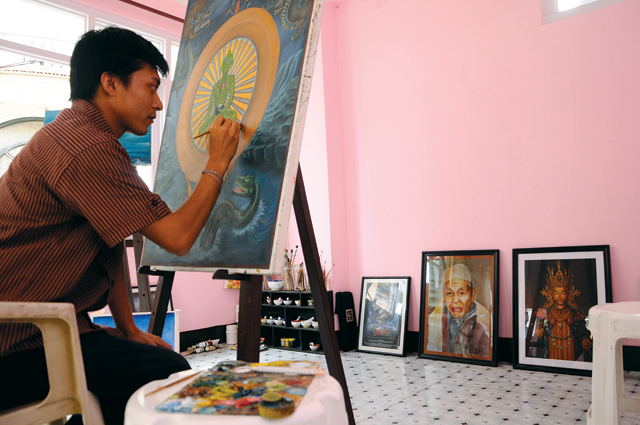A generation next artist who is painting a different stroke on the traditional paubha paintings
Change is inevitable - except from a vending machine.” Applying Robert C. Gallagher’s principle to the ancient art of paubha is Saziv Shakya from the Spiritual Arts, Patan Dhoka. A young artist who started his journey with metal crafting, he then ventured into several different forms of fine art before finally finding his place in the world of paubha art.

A religious Newari art form, paubha traditionally depicts deities, mandalas and monuments and is used to help the practitioner meditate. But Shakya begs to differ. He believes that paubha, which translates to “depiction of gods and goddesses in flat form,” is also another form of expression. “The pictures are filled with symbolism,” he states. “From the colour of the skin of the deities to the little details like a lotus flower or a bajra, each has its own meaning”. When asked to elaborate, he talks about how Mahadev is generally portrayed. “His eyes are always very calm even though there is a snake wrapped around his neck. It depicts a certain sense of peace even in the face of danger. Besides that, the moon and the water originating from his head each have their own significance”
Shakya started his journey in the world of art at the age of fifteen, learning from big names such as Lok Chitrakar and D.B Chitrakar. Nevertheless, he takes full credit for his own work. “It’s important to have good teachers. Still, they can only teach you so much. The thought and the concept, the hard work and the dedication that goes into the painting are your own.”
 For Shakya, a painting starts with an idea. “You get this idea, a certain feeling you want to depict in your art. Once you get that, you can’t stop till you’re finished. You keep thinking about it day in and day out, you do a lot of research. You just get so consumed by an idea that you can’t let it go until you have painted it.” For one of his illustrations, he collected every type of seed he could get his hands on and opened them up to see what was inside.
For Shakya, a painting starts with an idea. “You get this idea, a certain feeling you want to depict in your art. Once you get that, you can’t stop till you’re finished. You keep thinking about it day in and day out, you do a lot of research. You just get so consumed by an idea that you can’t let it go until you have painted it.” For one of his illustrations, he collected every type of seed he could get his hands on and opened them up to see what was inside.
Unlike many artists Shakya does not work with producers. Although he has been presented with offers, he keeps declining them as he doesn’t want his work to suffer due to commercialization. “The important thing is to be good at what you do. If your art is good you don’t need to worry about not having any buyers,” he says.
Having worked in this field for more than a decade, Shakya believes that there are signs of change in the industry. “Some fifteen years back, the paubha created were purely traditional. They were almost like a copy of previous established work. But now, the artists are adding their own touches to the paintings while still maintaining the basic essence of paubha. You can also see influences from other art forms now.”
Shakya, who himself has been known to incorporate metal carvings into his paubha paintings, approves whole-heartedly. “Change is something that has to happen,” he says. He believes that the catalysts for this particular change are the new generation of artists.
So, is paubha due for transformation in the hands of up and coming artists? Perhaps. But Shakya is adamant that despite changes in the technique or materials, as long as its core essence is preserved, paubha paintings will continue.









